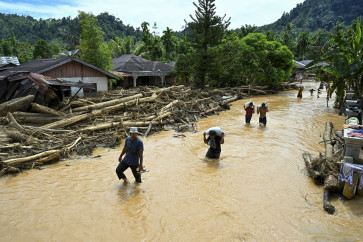Popular Reads
Top Results
Can't find what you're looking for?
View all search resultsPopular Reads
Top Results
Can't find what you're looking for?
View all search resultsAustralia's Byron Bay beach shrinks as sand disappears
Change text size
Gift Premium Articles
to Anyone
A
ustralia's Byron Bay usually conjures images of bathers lounging on sunkissed shores, or blissed-out longboarders cruising along cyan-blue waves -- but coastal erosion and lashing storms have reduced its seashore to a debris-strewn slither.
The tourist hotspot's main beach has been reduced to a thin strip by a sand-shifting phenomenon known as "headland bypassing". Recent wild storms have then eroded it further.
For more than six months, residents have watched helplessly as the beach has slowly disappeared because of what scientists say is the natural process of headland sand bypassing.
This occurs when sand moves from one beach to another around a rocky headland or cape, largely due to energy from waves, before eventually shifting back.
In recent days major storms brought strong winds and large waves, which have combined with high tides to worsen the sand losses -- leaving the beach reduced to a fraction of its former self.
Tom Murray, a coastal management researcher at Griffith University, said interventions such as dredging and artificial bypassing were not viable solutions to the problem.
Read also: Australia bushfire inquiry warns 'compounding disasters' to come
"By the time environmental assessments and legal processes have gone through this will have corrected naturally," he told public broadcaster ABC.
Murray said that although climate change is affecting wave patterns, any impact this might have on headland sand bypassing remains "poorly understood" and more research was needed.
Local media reported that lifeguards were forced to close the beach to swimmers in October after having insufficient space to set up their equipment.
Authorities have resorted to sandbagging in some areas as they attempt to shore up unstable sand dunes.
Parts of Australia's east coast have been experiencing wild storms, with heavy rainfall causing rivers to overflow, and authorities to issue flood evacuation orders in northern New South Wales on Tuesday.
However, the rain has also brought welcome relief to firefighters battling the first major blaze of the Australian summer, helping to douse a massive bushfire on Queensland's Fraser Island.











